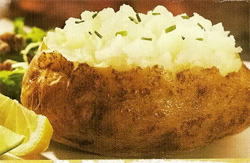Running & the Baked Potato

 The author wrote this 7 years ago and is now 55.
The author wrote this 7 years ago and is now 55.
If you are a diabetic, consult your doctor before starting a potato diet.
Beware! This section is for runners only.
+ Running past one hour consumes a lot of energy.
+ Glycogen and sucrose is consumed the most in long distance running.
+ If you want to run faster, you must store glycogen reserves.
+ The baked potato is one of the best food sources at storing glycogen.
I was a runner in High School (Payette, Idaho 75’-79’) and Junior College
(Ontario, Oregon 81’- 82’). Then I quit for awhile (quite awhile) and then took it back up at age 39, after
a 13 year siesta. I ran my first marathon at age 42 (what a painful bastard!). Then I ran two more marathons
(what more painful bastards!!). I want to attempt two or three more marathons before I reach age 55; and then
I’ll quit them gracefully, forever. My goal is to run the full 26 miles without stopping, and also to set a PR.
The problem with myself and marathons, besides the fact that I hate marathons, is
that I always hit-the-wall at mile 18. That is probably obvious because I rarely jog 18 miles. In the past 7 years,
I have only done about five or six 18-milers. That is poor marathon training. So I know the first step to a
‘better’ marathon is doing more 18 mile jogs.
The second step I believe is to utilize and store energy better. This I believe
is where the baked potato comes to play. At mile 18, I’m exhausted and feel out of energy. The baked potato is
loaded with the type of energy storage that are demanded and utilized in training for half- marathons and marathons.
The immediate source of energy our muscles use is from glucose and simple carbohydrates.
As time goes in endurance events, this source of energy goes away relatively fast. After it’s gone, the endurance-body
starts to rely on more complex carbohydrates for the body’s fuel source. Glycogen is the preferred complex carbohydrate
(carbs) storage needed for longer endurance events such as half-marathons and marathons.
Low Carbs = Low Energy
The food-value of glycogen is usually referred to as glycemic index, or GI index. The GI
index is a ranking of carbs on their effect on our blood glucose levels after consuming. The higher the GI index, the
more quickly that carbs are converted into glucose. This is good for runners after a long run (10 miles or more), but
may be bad for some people such as diabetics.
The GI index of some foods is shown:
Glycemic Index (GI)
Baked Potato……………..90
Mashed Potato……………70
Boiled Potato……………..56
Watermelon……………….85
White Rice………………..50
Brown Rice………………55
Green Pea Soup………….66
Apple……………………..38
Spaghetti………………….43
Whole Grain Breads………65
Grapes……………………..46
Banana…………………….55
Most of the GI data I
gathered is from
www.carbs-information.com
But anyone can look-up (google it) ‘foods and GI index’ and see that the baked potato is almost always
at the top, or near the top of the food chain for glycogen content and the glycemic index.
Many sports nutritionist’s suggestions to marathoners are eating complex carbs that are at
the medium to lower end of the GI scale. Carbohydrates at the upper end such as baked potatoes will often release carbs
faster into the blood stream. That is where I believe the baked potato is a good thing for runners training for half
marathons and marathons, and its value is under-estimated by many sports nutritionist. The baked potato can give runners
the badly needed fuel that is burned after a longer run and replace glucose and glycogen quicker than other food sources with
lower GI indexes. A runner needs a baked potato after every long run for quicker recovery and staleness prevention.
For more about the nutrition and fitness of potatoes, refer to the
Washington State Potato Commissions Potato Health Booklet.
A Spanish runner on one web-site described it perfectly with a formula.
Training + Restoring Carbohydrates = Higher Glycogen Stores in Muscles = Better Running Performance
Why 18 milers? Scientists have shown that the average runner’s carb-diets store about 1800 calories
in the body. An average runner will burn about 110 calories per mile. This means after about 16 miles, your body is out of carbs
(glycogen). By jogging 18 milers once or twice a week, you are training your body to run out of glycogen. After the run, you must
replenish it. If you calculate it out, that is nearly 2000 calories (18 miles x 110 calories/mile).
The lower GI foods will replenish the blood-glucose slower, and the higher GI foods, quicker. That
is the magic of a baked potato after each run while marathon training as part of a runner’s diet.
To achieve a faster half marathon or marathon, running is the first hurdle you must conquer. The
half-marathon requires frequent running at distances of 7 to 14 miles to do the half-marathon with some form of ease.
Marathons, however, are different. A Marathon is a 26.2 mile endurance event. To run this endurance
event efficiently requires numerous 18-milers before attempting a marathon. Who has the time to train for one of those all the time?
However, to run a good marathon efficiently, the 18 milers have to be done. If not, a person has no business at running a marathon.
This includes me if I can’t do them efficiently.
The second hurdle to conquer is energy storage. Jogging 18 miles will consume about 2000 calories. You
won’t be doing very many 18-milers if you cannot restore energy, ie., Glycogen after each long run. That is where one of my plans at
finishing a marathon in goal-time comes in. It is eating a baked potato everyday for at least 6 months before my targeted marathon date
as part of a dietary carbohydrate (carbo-loading) program.
Thus my marathon plan starts by picking the targeted marathon at least 6 months in advance. I will eat a
baked potato every day from the 6-month period to targeted marathon. During the first two months, I will run at least one 12-14 miler
each week. Four months from marathon date, I’ll increase the long runs to 18-milers, once a week. Three months from the date, I’ll
increase the 18-milers to twice each week. This will give about 20 total 18-milers before the targeted marathon.
About 3 to 4 weeks before the marathon, a runner may need to run one or two 22-milers as a test-drill
before the real event. During the 22 miler, the first 18 miles should seem easy because of the training and diet plan. By the end of 22
milers, a runner can determine if their carb program is on target or not.
To do this and recover quickly I believe that the baked potato can aid in a quicker recovery time after
an 18-miler, and also make the longer 18-milers feel much easier. I tried a mini-version of this for the half-marathon. At age 47, I cut
my half-marathon time from a 1:24:30 to a 1:17:55. I didn’t train any harder, but I did eat more baked potatoes. So, I believe, with
alittle more training and glycogen storage, both half-marathon and marathon times can come down with easier effort.
Any Comments? email me
John Taberna at:
taberna@cableone.net











